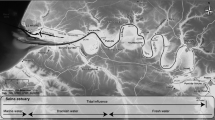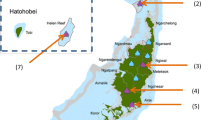Abstract
How has ecological knowledge been applied in Norwegian management of hydropower and protected areas? By recognizing a diversity of environmental ‘knowledges’ and science as potentially subordinated to political and economic interests, we explain the link between ecological knowledge and management by the state and scale of knowledge, political conflict and international commitments. The analysis is guided by case-study methodology. We find that ecological knowledge has had weak impact in the management reform of protected areas and been reduced as a decision-making premise in hydropower management. Differing combinations of case-specific factors have produced these outcomes. In the case of protected areas, ecological knowledge was suppressed mainly by opposing economic interests. The hydropower case showed how competing environmental knowledge and international commitments related to renewable energy and climate change overshadowed nature management concerns. These observations highlight the importance of differentiating between types of environmental knowledge and between knowledge and interests in the study of nature management.
Similar content being viewed by others
Notes
The project has financial support from the Research Council of Norway: Designing Knowledge-Based Management Systems for Environmental Governance in Norway. Project No. 230374. See also Andresen et al. (2017) for an introduction to the project.
On terminology: In our study, we use the more general concepts of environmental knowledge and scientific knowledge interchangeably and we use ecological knowledge to coin this more specific type of environmental knowledge. On the concepts of scientific knowledge and scientific advice, ‘advice’ is more often thought of as one step further in bridging the gap between scientific knowledge and its application in policy decisions. Regarding nature management, conservation and protection: we apply conservation as the most inclusive term, which includes management. The term protection is more specifically aimed at safeguarding species and ecosystems.
https://www.cbd.int/sp/targets/ The Strategic Plan for Biodiversity includes 20 time-bound, measurable targets to be met by the year 2020 (Aichi Biodiversity Targets) (adopted at the CBD COP 10 in Japan).
This trend was evident already in the deployment of local-level environmental experts, a policy that was introduced around 1994 with Agenda 21 and then discontinued, as central funding for these experts was terminated a few years later (Bjørnes and Lafferty 2000).
References
Agrawal, A., & Ribot, J. C. (1999). Accountability in decentralization: A framework with South Asian and West African Cases. Journal of Developing Areas, 33(Summer), 473–502.
Andresen, S., & Rosendal, G. K. (2017). The panel on climate change and the intergovernmental platform on biodiversity and ecosystem services. ASJP African and Francophone Air and Space Power Journal, 8(2), 45–61.
Andresen, S., Rosendal, G. K., & Skjærseth, J. B. (2017). Designing knowledge-based, integrated management systems for environmental governance. In Ariel Dinar (Ed.), Natural resources and environmental policy in the era of global change (pp. 439–456). Singapore: World Scientific.
Bell, S., Morse, S., & Shah, R. A. (2012). Understanding stakeholder participation in research as part of sustainable development. Journal of Environmental Management, 101, 13–22.
Biermann, F., et al. (2010). Earth system governance: A research framework. International Environment Agreements: Politics, Law and Economics, 10(4), 277–298.
Bjørnes, T., & Lafferty, W. (2000). Miljøvernlederstillinger og Lokal Agenda 21. Hva er status? Report 1/2000, SUM, University of Oslo.
Buan, I. F., Eikeland, P. O., & Inderberg, T. H. (2010). Rammebetingelser for utbygging av fornybar energi i Norge, Sverige og Skottland: Sammenligning av faktorer som motiverer og modererer investeringer ‘Framework Conditions for Development of Renewable Energy in Norway, Sweden and Scotland: Comparison of Factors that Motivate and Moderate Investments), In Norwegian, FNI Report 6/2010, Lysaker: FNI.
Chong, J. (2014). Ecosystem-based approaches to climate change adaptation: Progress and challenges. International Environment Agreements: Politics, Law and Economics, 14(4), 391–405.
DN (Norwegian Directorate for Nature Management). (2008). Lokal forvaltning av verneområder. En evaluering av delegering, Tilrådning til Miljøverndepartementet. Trondheim: DN.
Dooley, K. (2018). Land-based negative emissions: risks for climate mitigation and impacts on sustainable development. International Environment Agreements: Politics, Law and Economics, 18(1), 79–98.
EC. (2008). The economics of ecosystems and biodiversity. European Communities/Wesseling: Welzel and Hardt.
Eikeland, P. O & Schei, P. J. (2019). Use of research-based ecological knowledge in national resource management: The case of Norwegian hydropower management. FNI report, forthcoming 2019. Lysaker: Fridtjof Nansen Institute.
Falleth, E.I. & Hovik, S. (2008). Lokal forvaltning av store verneområder. Tidsskrift for utmarksforskning 1. http://utmark.nina.no/portals/utmark/utmark_old/utgivelser/pub/2008-1/art/Falleth_Hovik_2_Utmark_1_2008.html.
FAO. (2009). State of the world’s forests. Rome: FAO.
Fauchald, O. K., & Gulbrandsen, L. H. (2012). The Norwegian reform of protected area management: A grand experiment with delegation of authority? Local Environment, 17(2), 203–222.
Fauchald, O. K. & Gulbrandsen, L. H. (forthcoming 2019). Reforming protected area management in Norway: What role for knowledge? Working paper, Fridtjof Nansen Institute.
Fauchald, O. K., Gulbrandsen, L. H., & Zachrisson, A. (2014). Internationalization of protected areas in Norway and Sweden: examining pathways of influence in similar countries. International Journal of Biodiversity Science, Ecosystem Services & Management, 10(3), 240–252. https://doi.org/10.1080/21513732.2014.938122.
GEO. (2012). Global environmental outlook. Nairobi: UNEP.
Gillom, S. (2014). Science in carbon economies: debating what counts in US biofuel governance. Environment and Planning A, 46(2), 318–336.
Haas, P. M. (1992). Introduction: Epistemic communities and international policy coordination. International Organization, 46(1), 1–35.
Haas, P. (2004). When does power listen to truth? A constructivist approach to the policy process. Journal of European Public Policy, 11(4), 569–592.
IEA (2012). Technology Roadmap Hydropower. Paris: IEA, https://www.iea.org/publications/freepublications/publication/2012_Hydropower_Roadmap.pdf.
Innst. O. nr. 64, 1995–1996. The Norwegian Parliament. Oslo, energi- og miljøkomiteen, den 29. mai 1996.
IPCC (2014). Climate change 2014. Synthesis Report. WHO/UNEP. https://www.ipcc.ch/report/ar5/. Accessed December 01, 2017.
IUCN (2011). Guidelines for protected areas legislation, IUCN Environmental Policy and Law Paper No. 81. IUCN Publication service: Gland.
Jasanoff, S. (1990). The fifth branch: Science advisers as policymakers. Cambridge, MA: Harvard University Press.
Josefsson, H. (2015). Good Ecological Status—Advancing the Ecology of Law, Dissertation University of Uppsala, Sweden.
Karr, J., & Dudley, D. (1981). Ecological perspective on water quality goals. Environmental Management, 5(1), 55–68.
L’Abée-Lund, J.H. & J.O. Villar, (2017). Start-stop practice in small Norwegian hydropower plants, NVE Report 9/17, Oslo: Norwegian Water Resources and Energy Directorate.
Lane, M. (2001). Affirming new directions in planning theory: Co-management of protected areas. Society and Natural Resources, 14(8), 657–671.
March, J. G., & Olsen, J. P. (1995). Democratic Governance. New York: Free Press.
MEA, Millennium Ecosystem Assessment. (2005). Ecosystems and human well-being: Biodiversity synthesis. Washington, DC: Island Press.
Miles, E. L., Underdal, A., Andresen, S., Wettestad, J., Skjærseth, J. B., & Carlin, E. M. (2002). Environmental regime effectiveness: Confronting theory with evidence. Cambridge, MA: MIT Press.
Mitchell, R. B., Clark, W. C., & Cash, D. W. (2006). Information and influence. In R. B. Mitchell, W. C. Clark, D. W. Cash, & N. M. Dickson (Eds.), Global Environmental Assessments: Information and Influence. Cambridge, MA: MIT Press.
NEA, Norwegian Environment Agency. (2012). Miljøstatus.no—vassdragsregulering (the State of the environment), http://www.miljostatus.no/Tema/Ferskvann/Vassdragsregulering/.
Norwegian Ministry of Petroleum and Energy. (2015). Fakta—Energi og vannressurser i Norge (Facts—Energy and water resources in Norway), Oslo: Norwegian Ministry of Petroleum and Energy, https://www.regjeringen.no/contentassets/fd89d9e2c39a4ac2b9c9a95bf156089a/1108774830_897155_fakta_energi-vannressurser_2015_nett.pdf.
Norwegian Ministry of the Environment. (2009–2010). Prop. 1 S (2009–2010). Oslo: Det kongelige miljøverndepartement.
Norwegian Water Resources and Energy Administration. (1993). Inngrep i vassdrag; konsekvenser og tiltak—en kunnskapsoppsummering. Publ. nr. 13/1993. Oslo: Norwegian Water Resources and Energy Administration.
Palmer, J. (2014). Biofuels and the politics of land-use change: tracing the interactions of discourse and place in European policy-making. Environment and Planning A, 46(2), 337–352.
Reed, S. M. (2008). Stakeholder participation for environmental management: A literature review. Biological Conservation, 141(10), 2417–2431.
Riseth, J. A. (2006). An indigenous perspective on national parks and Sami reindeer management in Norway. Geographical Research, 45(2), 177–185.
Rosendal, G. K. (2004). Biodiversity: international bungee jump—domestic bungle. In J. B. Skjærseth (Ed.), International Regimes and Norway’s Environmental Policy: Crossfire and Coherence (pp. 161–194). Aldershot: Ashgate.
Rosendal, G. K. (2007). Norway in UN environmental policies: Ambitions and influence. Journal of International Environmental Agreements: Politics, Law and Economics, 7, 439–455. Special Issue.
Skjærseth, J. B. (2004). International regimes and Norway’s environmental policy: Crossfire and coherence. Aldershot: Ashgate.
Smith, S. R., & Ingram, H. (2002). Policy tools and democracy. In Lester Salamon (Ed.), The tools of government: A guide to the new governance (pp. 565–584). New York: Oxford University Press.
Stauffer, R.B (1957). Haeckel, Darwin, and ecology. Quarterly Review of Biology, 32 (2), 138–144 http://www.jstor.org/stable/2816117.
TEEB. (2010). The Economics of ecosystems and biodiversity: Mainstreaming the economics of nature: A synthesis of the approach, conclusions and recommendations of TEEB. Geneva: Switzerland.
Thompson Hobbs, N. (2003). Challenges and opportunities in integrating ecological knowledge across scales, Forest Ecology and Management, 3 August, 223–238.
Underdal, A. (2000). Science and politics: The anatomy of an uneasy partnership. In S. Andresen, T. Skodvin, A. Underdal, & J. Wettestad (Eds.), Science and politics in international environmental regimes. Manchester: Manchester University Press.
Underdal, A. (2010). Complexity and challenges of long-term environmental governance. Global Environmental Change, 20(3), 386–393. https://doi.org/10.1016/j.gloenvcha.2010.02.005.
Underdal, A., & Hanf, K. (Eds.). (2000). International environmental agreements and domestic politics: The case of acid rain. Aldershot: Ashgate.
UNEP. (2009). The natural fix: The role of ecosystems in climate mitigation. Cambridge: UNEP.
Verissimo, D., MacMillan, D. C., Smith, R. J., Crees, J., & Davies, Z. (2014). Has climate change taken prominence over biodiversity conservation? BioScience Talks, 64(7), 625–629.
Wallbott, L., & Rosendal, G. K. (2018). Safeguards, standards, and the science-policy interfaces of REDD+: Greening land use through forest-based mitigation in Costa Rica? Journal of Environment and Development, 12(1), 99–125.
White Paper. (2006–2007). Regjeringens miljøpolitikk og rikets miljøtilstand. St.meld. 26. Miljøverndepartementet, Oslo.
White Paper. (2013). Naturens goder—om verdier av økosystemtjenester (Nature’s benefits—on the value of ecosystem services). NOU 2013:10, Miljøverndepartementet, Oslo.
White Paper. (2015–2020). Natur for livet. (Nature for life). Meld. St. 14. Klima og miljødepartementet, Oslo.
Yin, R. K. (2003). Case study research: Design and methods (3rd ed.). London: SAGE.
Funding
Funding was provided by Norges Forskningsråd (Project No. 230374).
Author information
Authors and Affiliations
Corresponding author
Additional information
Publisher's Note
Springer Nature remains neutral with regard to jurisdictional claims in published maps and institutional affiliations.
Rights and permissions
About this article
Cite this article
Rosendal, K., Skjærseth, J.B. & Andresen, S. Knowledge-based management of protected areas and hydropower: the case of Norway. Int Environ Agreements 19, 515–530 (2019). https://doi.org/10.1007/s10784-019-09447-6
Accepted:
Published:
Issue Date:
DOI: https://doi.org/10.1007/s10784-019-09447-6




